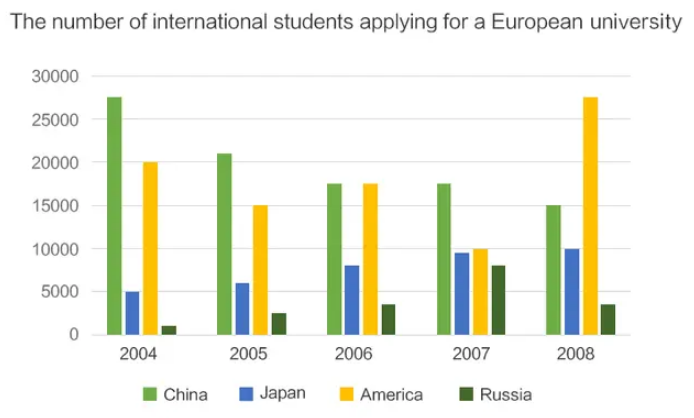The chart below shows the number of international applicants to the universities of one European country. Summarize the information by selecting and reporting the main features, and make comparisons where relevant. Write at least 150 words.

Bài mẫu
The chart provides an overview of the number of international applicants from China, Japan, the USA, and Russia to universities in a European country, tracked between 2004 and 2008.
Overall, while the number of applicants from China decreased over the period, those from Japan and the USA increased steadily. Russia consistently had the lowest number of applicants throughout the timeframe.
In 2004, China led the way, with approximately 27,000 students applying for higher education in the European country. In stark contrast, Russia had the fewest applicants, with around 2,500. Over the next few years, the number of Chinese applicants declined significantly to 17,000 in 2006 and then dropped slightly further to just over 15,000 by 2008. During the same period, the number of Russian applicants showed only minor fluctuations, staying close to the initial figure.
At the start of the period, the USA had around 13,000 applicants, which was double the number of Japan’s 6,000. Both countries experienced a steady increase in applicants over the years. By 2006, the number of American applicants equaled that of China and still maintained a figure twice as high as Japan’s. Subsequently, the USA surpassed China, securing the top position with 27,000 applicants in 2008. Japan also saw a consistent upward trend, albeit less pronounced, concluding the period with 10,000 applicants.
Từ vựng hay trong bài
- international applicants (n): ứng viên quốc tế
Giải thích: people applying from outside the country
Ví dụ: The university received a large number of international applicants this year.
- timeframe (n): khung thời gian
Giải thích: a period during which something occurs
Ví dụ: The project must be completed within the specified timeframe.
- lead the way (v): dẫn đầu
Giải thích: take the leading position
Ví dụ: The company led the way in technological innovation.
- in stark contrast: trái ngược hoàn toàn
Giải thích: in complete opposition
Ví dụ: In stark contrast to last year, sales have decreased significantly.
- minor fluctuations (n): những biến động nhỏ
Giải thích: small variations or changes
Ví dụ: The stock market showed only minor fluctuations this week.
- double (v): gấp đôi
Giải thích: to increase by twice the amount
Ví dụ: The company’s profits more than doubled last year.
- experience a steady increase (v): trải qua sự tăng trưởng ổn định
Giải thích: to go through a continuous rise
Ví dụ: The population of the city experienced a steady increase over the decade.
- equal (v): bằng
Giải thích: became the same in number or amount
Ví dụ: His performance equaled the world record.
- see a consistent upward trend (v): nhìn thấy xu hướng tăng liên tục
Giải thích: to notice a steady increase over time
Ví dụ: The industry saw a consistent upward trend in demand.
- albeit: mặc dù
Giải thích: although
Ví dụ: The project was successful, albeit delayed by a few months.
Bạn đang chuẩn bị cho kì thi IELTS?
Hãy tham khảo Khóa Học IELTS Online qua ZOOM cùng cô Thanh Loan
IELTS Thanh Loan – giáo viên 10 năm kinh nghiệm – trực tiếp đứng lớp, tự tin mang đến khóa học chất lượng nhất, phương pháp giảng dạy cô đọng dễ hiểu, giáo trình tự biên soạn cho lộ trình từ cơ bản đến luyện đề chuyên sâu. Đặc biệt, học viên luôn được quan tâm sát sao nhất, hỗ trợ không giới hạn, thúc đẩy kỷ luật học tập tốt để đạt mục tiêu.

Lược dịch tiếng Việt
Biểu đồ cung cấp tổng quan về số lượng ứng viên quốc tế từ Trung Quốc, Nhật Bản, Hoa Kỳ và Nga vào các trường đại học ở một quốc gia châu Âu, được theo dõi từ năm 2004 đến năm 2008.
Nhìn chung, trong khi số lượng ứng viên từ Trung Quốc giảm trong giai đoạn này, thì số lượng ứng viên từ Nhật Bản và Hoa Kỳ lại tăng đều đặn. Nga luôn có số lượng ứng viên thấp nhất trong suốt khung thời gian này.
Năm 2004, Trung Quốc dẫn đầu với khoảng 27.000 sinh viên nộp đơn xin học đại học tại quốc gia châu Âu này. Ngược lại hoàn toàn, Nga có ít ứng viên nhất với khoảng 2.500. Trong vài năm tiếp theo, số lượng ứng viên Trung Quốc giảm đáng kể xuống còn 17.000 vào năm 2006 và sau đó giảm nhẹ xuống còn hơn 15.000 vào năm 2008. Trong cùng kỳ, số lượng ứng viên Nga chỉ có biến động nhỏ, gần với con số ban đầu.
Vào đầu giai đoạn này, Hoa Kỳ có khoảng 13.000 ứng viên, gấp đôi số lượng 6.000 của Nhật Bản. Cả hai quốc gia đều có sự gia tăng ổn định về số lượng ứng viên qua các năm. Đến năm 2006, số lượng ứng viên người Mỹ bằng với Trung Quốc và vẫn duy trì con số cao gấp đôi Nhật Bản. Sau đó, Hoa Kỳ đã vượt qua Trung Quốc, giành vị trí dẫn đầu với 27.000 ứng viên vào năm 2008. Nhật Bản cũng chứng kiến xu hướng tăng đều đặn, mặc dù không rõ rệt, kết thúc giai đoạn với 10.000 ứng viên.
Xem thêm:













